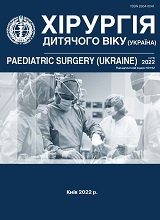Buried penis surgical correction technique optimization in children
DOI:
https://doi.org/10.15574/PS.2022.76.68Keywords:
buried penis, surgery, childrenAbstract
The purpose - to optimize the buried penis surgical treatment method in children for the most adequate functional and cosmetic results.
Materials and methods. The clinical material includes 28 boys with a buried penis between the ages of 11 months to 7 years. Among them 9 (32.14%) children were admitted for repeated surgical interventions with unsatisfactory cosmetic results after previous surgical interventions in other medical institutions.
Results. The method of surgical correction of the buried penis in children was offered. In patients whose penis glans could not be exposed, the foreskin stenotic ring was dissected on both sides on the lateral surfaces, or scar-altered tissues were partially excised circularly. During the maximum vertical traction per the ligature on the penis head, the skin at the base of the penis was circularly dissected. The dissection of the skin was extended to the inguinal folds on both sides. The penis spongy and cavernous bodies were skeletonized from the coronal sulcus to the pubic joint with careful excision of inelastic embryonic cords and scars. The skin of the anterior abdominal wall was lifted up with the help of traction ligatures or hooks and mobilized in an acute way. Maximum excision of subcutaneous fat in the suprapubic and inguinal areas was performed. The penis was moved into the hole formed in the lower part of the demobilized skin flap in the suprapubic area. For stable fixation of the penis, the deep fascia at the base of the corpora cavernosa was sutured to the pubic tubercle at maximum traction per the head, and the skin flap of the anterior abdominal wall was sutured with internal sutures to the crest of the upper pubic bone. The penis trunk was closed due to a sufficiently mobile foreskin, shifting the skin to the penoscrotal angle in the area of the formed hole in the abdomen skin flap. The postoperative wound was sutured in layers.
Conclusions. Clinical differentiation of different types for penis size «visual» reduction in boys will allow a balanced approach to adequate correction of the defect.
The proposed method of buried penis surgical correction in boys eliminates all the preconditions of the defect and demonstrates good anatomical, functional and cosmetic results.
The research was carried out in accordance with the principles of the Helsinki Declaration. The study protocol was approved by the local ethics committee of the listed institution. Informed consent of children and their parents was obtained for the research.
No conflict of interests was declared by the authors.
References
Borsellino A, Spagnoli A, Vallasciani S, Martini L, Ferro F. (2007). Surgical approach to concealed penis: technical refinements and outcome. Urology. 69 (6): 1195-1198. https://doi.org/10.1016/j.urology.2007.01.065; PMid:17572214
Crawford BS. (1977). Buried penis. British Journal of Plastic Surgery. 30 (1): 96-99. https://doi.org/10.1016/S0007-1226(77)90046-7
Ge W, Zhu X, Xu Y, Chen Y, Wang J. (2019). Therapeutic effects of modified Devine surgery for concealed penis in children. Asian journal of surgery. 42 (1): 356-361. https://doi.org/10.1016/j.asjsur.2018.06.007; PMid:30193770
Johnston JH. (1977). Other penile abnormalities. Surgical Pediatric Urology. Eckstein EB, Hohenfellner R, Williams DI, Eds. WB Saunders, Philadelphia, Pa, USA: 406.
King ICC, Tahir A, Ramanathan C, Siddiqui H. (2013). Buried penis: evaluation of outcomes in children and adults, modification of a unified treatment algorithm, and review of the literature. International Scholarly Research Notices. https://doi.org/10.1155/2013/109349; PMid:24490087 PMCid:PMC3893803
Maizels M, Zaontz M, Donovan J. (1986). Surgical correction of the buried penis: description of a classification system and a technique to correct the disorder. Journal of Urology. 136 (1): 268-271. https://doi.org/10.1016/S0022-5347(17)44837-3
Nakonechnyy RA, Nakonechnyi AY. (2020). Method of surgical correction of buried penis in boys. Aplication No. u202003035 dated 21.05.2020. Patent of Ukraine for utility model No. 144788 dated 26.10.2020. Publ. Bull. No. 20.
Ockleford C. (2012). The Netter Collection of Medical Illustrations: Reproductive system. Journal of Anatomy. 220 (1): 117. https://doi.org/10.1111/j.1469-7580.2011.01445.x; PMCid:PMC3248671
Palmer LS, Palmer JS. (2016). Management of abnormalities of the external genitalia in boys. Campbell-Walsh Urology. 11th ed. Philadelphia. PA: Elsevier: 3368-3398.
Srinivasan AK, Palmer LS, Palmer JS. (2011). Inconspicuous penis. The Scientific World Journal. 11: 2559-2564. https://doi.org/10.1100/2011/238519; PMid:22235186 PMCid:PMC3253616
Xu XW, Xu YT, Shen ZJ, Li DJ, Gu W, Huang RQ. (2011). Devine's technique with free skin grafting for concealed penis with prepuce deficit. Zhonghua nan ke xue National Journal of Andrology. 17 (7): 625-627.
Downloads
Published
Issue
Section
License
Copyright (c) 2022 Paediatric Surgery (Ukraine)

This work is licensed under a Creative Commons Attribution-NonCommercial 4.0 International License.
The policy of the Journal “PAEDIATRIC SURGERY. UKRAINE” is compatible with the vast majority of funders' of open access and self-archiving policies. The journal provides immediate open access route being convinced that everyone – not only scientists - can benefit from research results, and publishes articles exclusively under open access distribution, with a Creative Commons Attribution-Noncommercial 4.0 international license(СС BY-NC).
Authors transfer the copyright to the Journal “PAEDIATRIC SURGERY.UKRAINE” when the manuscript is accepted for publication. Authors declare that this manuscript has not been published nor is under simultaneous consideration for publication elsewhere. After publication, the articles become freely available on-line to the public.
Readers have the right to use, distribute, and reproduce articles in any medium, provided the articles and the journal are properly cited.
The use of published materials for commercial purposes is strongly prohibited.

